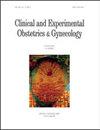Application of Ligation of Internal Iliac Artery and Uterine Artery in Pernicious Placenta Previa
IF 0.6
4区 医学
Q4 OBSTETRICS & GYNECOLOGY
引用次数: 0
Abstract
Backgrounds: To investigate the use of vascular ligation in the treatment of pernicious placenta previa. Methods: Clinical data from 199 patients with pernicious placenta previa were collected and divided into groups according to placenta location, placenta accretion and vessel ligation, the pregnancy outcome of each group was compared. Results: The unplanned reoperation rate was lower for the internal iliac artery ligation group than the group without internal iliac artery ligation (p < 0.05). The intraoperative bleeding volume, blood transfusion volume, and intensive care unit (ICU) admission rate were lower for the prophylactic internal iliac artery ligation group than the therapeutic ligation group (p < 0.05), and in the hysterectomy patients, intraoperative bleeding was lower in the prophylactic internal iliac artery ligation group than the therapeutic ligation group (p < 0.05). The hysterectomy rate was lower for the uterine artery ligation group than the group without uterine artery ligation (p < 0.05); and for superficial and deep placental accreta, the operation time of uterine artery ligation group was shorter than internal iliac artery ligation group, intraoperative bleeding volume, blood transfusion volume, and ICU admission rate have no significant difference, when placental penetrating implantation was performed, patients with internal iliac artery ligation were statistically more severely ill, but there was no difference in prognosis. Conclusions: Vascular ligation is an effective means of managing high-risk obstetric bleeding and helps to avoid hysterectomy and unplanned reoperation, but surgeons need to choose the appropriate ligation method to improve patient prognosis, considering the patient’s condition and his or her skills.髂内动脉和子宫动脉结扎术在恶性前置胎盘中的应用
背景:探讨血管结扎术在恶性前置胎盘治疗中的应用。方法:收集199例恶性前置胎盘患者的临床资料,根据胎盘位置、胎盘增生及血管结扎情况进行分组,比较各组妊娠结局。结果:髂内动脉结扎组意外再手术率低于未结扎组(p <0.05)。预防性髂内动脉结扎组术中出血量、输血量、ICU入院率均低于治疗性结扎组(p <在子宫切除术患者中,预防性髂内动脉结扎组术中出血低于治疗性结扎组(p <0.05)。子宫动脉结扎组子宫切除术率低于未结扎组(p <0.05);对于浅、深胎盘增积,子宫动脉结扎组手术时间短于髂内动脉结扎组,术中出血量、输血量、ICU入院率均无显著差异,行胎盘穿透植入时,髂内动脉结扎组病情严重程度有统计学意义,但预后无差异。结论:血管结扎术是治疗高危产科出血的有效手段,可避免子宫切除术和无计划再手术,但需结合患者的病情和技能选择合适的结扎方法,以改善患者预后。
本文章由计算机程序翻译,如有差异,请以英文原文为准。
求助全文
约1分钟内获得全文
求助全文
来源期刊
CiteScore
0.50
自引率
0.00%
发文量
241
审稿时长
1 months
期刊介绍:
CEOG is an international, peer-reviewed, open access journal. CEOG covers all aspects of Obstetrics and Gynecology, including obstetrics, prenatal diagnosis, maternal-fetal medicine, perinatology, general gynecology, gynecologic oncology, uro-gynecology, reproductive medicine, infertility, reproductive endocrinology, sexual medicine. All submissions of cutting-edge advances of medical research in the area of women''s health worldwide are encouraged.

 求助内容:
求助内容: 应助结果提醒方式:
应助结果提醒方式:


